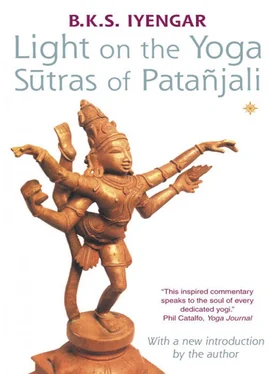1 ...8 9 10 12 13 14 ...20 Once the principles have been withdrawn into their root, their potential remains dormant, which is why a person in the state of samadhi is but can not do; the outward form of nature has folded up like a bird’s wings. If the sadhaka does not pursue his sadhana with sufficient zeal, but rests on his laurels, the principles of nature will be re-activated to ill effect. Nature’s turbulence will again obscure the light of the purusa as the sadhaka is again caught up in the wheel of joy and sorrow. But he who has reached the divine union of purusa and prakrti, and then redoubles his efforts, has only kaivalya before him.
Characteristics of Purusa
Purusa, the seer or the soul, is absolute pure knowledge. Unlike nature (prakrti), which is subject to change, purusa is eternal and unchanging. Free from the qualities of nature, it is an absolute knower of everything. The seer is beyond words, and indescribable. It is the intelligence, one of nature’s sheaths, which enmeshes the seer in the playground of nature and influences and contaminates its purity. As a mirror, when covered with dust, cannot reflect clearly, so the seer, though pure, cannot reflect clearly if the intelligence is clouded. The aspirant who follows the eightfold path of yoga develops discriminative understanding, viveka , and learns to use the playground of nature to clear the intelligence and experience the seer.
Everyone has an inborn desire to develop sensitivity and maturity in intelligence. That is why God has provided the principles of nature – so that the seer can commune with them and make the fullest use of them for his intellectual and spiritual growth. Nature is there to serve its master, the seer, purusa or atman , the inner being of man. It becomes an obstacle to spiritual enlightenment when used for sensual pleasure, but on the other hand it can help its master to realize his potential and true stature. It is not the fault of nature if human beings abuse it or fall prey to its temptations. Nature is always ready to oblige, or to remain ineffectual, according to our deeds. When we have overcome our intellectual and emotional defects, nature’s gifts readily serve us for realization of the soul. Having fulfilled their functions, they withdraw.
This true Self-Realization is the peak of development of intelligence. It must be sustained, with uninterrupted awareness, in thought, word and deed: then the purpose of nature’s contact with and withdrawal from the seer are fully understood. All sorrows and hatred are washed away, and everlasting unalloyed peace come to the seeker. Nature continues to taunt throughout life, with afflictions and uncertainties, those who have no discriminative power and awareness.
After explaining the functions of nature and of the seer, Patañjali speaks of the seven states of understanding or wisdom ( prajña ) that emerge from the release of nature’s contact with the seer. First let us identify the seven corresponding states of ignorance, or avidya :
1 smallness, feebleness, insignificance, inferiority, meanness
2 unsteadiness, fickleness, mutability
3 living with pains, afflictions, misery, agony
4 living with the association of pain
5 mistaking the perishable body for the Self
6 creating conditions for undergoing sorrow
7 believing that union with the soul (yoga) is impossible, and acting as though that were so
The seven states of wisdom are:
1 knowing that which has to be known
2 discarding that which is to be discarded
3 attaining that which has to be attained
4 doing that which has to be done
5 winning the goal that is to be won
6 freeing the intelligence from the pull of the three gunas of nature
7 achieving emancipation of the soul so that it shines in its own light
These seven states of wisdom are interpreted as right desire, right reflection, disappearance of memory and mind, experiencing pure sattva or the truth (reality), indifference to praise and blame, reabsorption of phenomenal creation, and living in the vision of the soul. They may be further simplified as:
1 understanding the body within and without
2 understanding energy and its uses
3 understanding mind
4 consistency of will
5 awareness of experience
6 awareness of pure quintessence, sentiment and beauty
7 understanding that the individual soul, jivatman , is a particle of the Universal Spirit, Paramatman
The Yoga Vasista correlates this sutra (II.27) with the seven stages of individual development:
1 study and cultivation of the company of wise men
2 capacity to solve problems
3 development of non-attachment
4 dissolution of inherent faults
5 working towards the bliss in which a half-sleeping and half-wakeful state is experienced
6 experience of a deep sleep state
7 attaining a state in which purity, tranquillity and compassion flow out towards others.
The seven frontiers of awareness also correlate with the five sheaths or kosas of the body. Consciousness is the sixth, and the inner self, the seventh.
Patañjali describes the seven states of awareness as:
1 emerging consciousness ( vyutthana citta )
2 refraining consciousness ( nirodha citta )
3 tranquil consciousness (santa citta)
4 one-pointed consciousness ( ekagra citta )
5 sprouted consciousness ( nirmana citta )
6 rent consciousness ( chidra citta )
7 pure consciousness ( divya citta )
(See III.9, 10, 11; IV.27 and 29.)
It is also possible to consider the ethical, physical, physiological, neurological, emotional, intellectual and spiritual domains as the seven states of awareness. When one rests on the vision of the soul, divinity is felt in this empirical state.
The yogic disciplines are yama (restraint) and niyama (practice or observance). These disciplines channel the energies of the organs of action and the senses of perception in the right direction. Asana (posture) results in balance, stillness of mind, and power to penetrate the intelligence. Through Asana we learn to know the body well and to distinguish between motion and action: motion excites the mind while action absorbs it. Pranayama (control of energy through restraint of breath) and pratyahara (withdrawal of the senses) help the sadhaka to explore his hidden facets, and enable him to penetrate the core of his being. dharana (concentration), dhyana (meditation) and samadhi (total absorption) are the fulfilment of yogic discipline, the essence or natural constituents of yoga. They develop when the other five disciplines have been mastered. Actually, all eight intermingle and interweave to form the whole seamless body of yoga.
There are five yamas: ahimsa (non-violence or non-injury), satya (truthfulness), asteya (non-stealing), brahmacarya (continence) and aparigraha (freedom from avarice or non-covetousness).
Intending no harm in word, thought or deed; being sincere, honest and faithful; being careful not to misappropriate another’s wealth; being chaste and not coveting the possessions of others or accepting gifts, are the practices of yama. It is essential they be observed and followed. They are to be practised individually and collectively irrespective of lineage, place, time, condition or career. The yamas are mighty universal vows, says Patañjali.
Читать дальше












